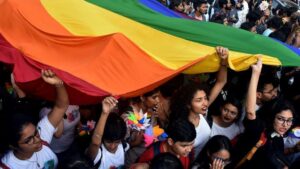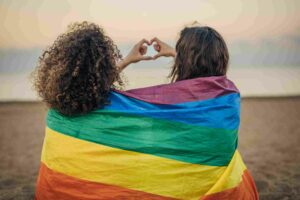Performative bisexuality is a term coined in sociological studies. It is often used to reference the act of individuals claiming or performing bisexuality for the purpose of gaining attention or for any other secondary benefits rather than expressing a genuine sexual orientation. In this blog, we will delve into various dimensions of performative bisexuality, its socio-cultural implications, and the significance of authentic sexual expression.
Contents
Understanding Performative Bisexuality
 Performative bisexuality is a sociological term that refers to the act of individuals portraying or claiming bisexuality for reasons beyond authentic sexual attraction to both genders. This could be for gaining attention, appealing to potential partners, or reaping other secondary benefits. It is not an expression of true sexual orientation. But rather a strategy for achieving certain social or personal objectives.
Performative bisexuality is a sociological term that refers to the act of individuals portraying or claiming bisexuality for reasons beyond authentic sexual attraction to both genders. This could be for gaining attention, appealing to potential partners, or reaping other secondary benefits. It is not an expression of true sexual orientation. But rather a strategy for achieving certain social or personal objectives.
This concept is complex and nuanced. It’s important to note that performative bisexuality doesn’t negate the existence or validity of authentic bisexuality. Genuine bisexuality is a legitimate sexual orientation, indicating attraction to both men and women. However, when bisexuality is used as a tool for attention or benefits rather than an authentic expression of one’s sexual orientation, it falls into the realm of performative bisexuality.
Origins and Evolution Of This Bisexuality
The origins of performative bisexuality can be traced back to the intersections of sociocultural change, evolving media landscapes, and the increasing visibility of LGBTQ+ individuals. From a historical perspective, Western societies have primarily been dichotomous in understanding and accepting sexual orientations. And acknowledging largely heteronormative relations. This limited understanding began to shift, especially with the liberation movements of the late 20th century.
During the sexual revolution of the 1960s and 1970s, societal norms and values began to change. And this resulted in more open discussions about sexuality and sexual orientation. However, the increased visibility of non-heteronormative sexual identities also led to their commodification in certain contexts. Especially in media and pop culture.
Thus, the portrayal of bisexuality began to be seen as a ‘trend’ or an ‘exciting twist’. It’s a phenomenon that was exploited for viewership, titillation, or attention-grabbing. In the 2000s, with the advent of reality TV and the digital age, the concept of performative bisexuality began to gain traction. Popular culture started to depict bisexuality, but not always in authentic ways.
Instead, it was often portrayed as an adventurous choice, an experiment, or even a phase, rather than a legitimate sexual orientation. Therefore, it has been deeply intertwined with societal views on bisexuality and the LGBTQ+ community at large.
Impacts of Performative Bisexuality on the LGBTQ+ Community
 Performative bisexuality can have significant impacts on the LGBTQ+ community. Particularly on those who identify as genuinely bisexual. Some of these impacts are listed below:
Performative bisexuality can have significant impacts on the LGBTQ+ community. Particularly on those who identify as genuinely bisexual. Some of these impacts are listed below:
Perpetuation of harmful stereotypes
Performative bisexuality often propagates harmful stereotypes, such as the notion that bisexuality is a phase, a choice, or attention-seeking behavior. This invalidates the experiences of those who genuinely identify as bisexual and contributes to ‘bisexual erasure’ or ‘biphobia’, where bisexuality is dismissed or denied as a valid sexual orientation.
Undermining Authentic Experiences
By depicting bisexuality as something that can be adopted and discarded at will, performative bisexuality undermines the experiences, struggles, and identity crises faced by individuals who are genuinely exploring their bisexuality.
Misrepresentation in Media and Pop Culture
Media and pop culture often capitalize on the ‘exoticism’ of bisexuality for plot lines or character development, thereby further propagating the idea of performative bisexuality. This often leads to a lack of nuanced, authentic representations of bisexual individuals in media.
Emotional Impact
For genuine bisexual individuals, seeing bisexuality treated as a performance can be emotionally damaging. It can lead to feelings of invalidation, and alienation. And a lack of acceptance both within and outside the LGBTQ+ community.
Creating Division within the LGBTQ+ Community
The phenomenon of performative bisexuality can also lead to divisions within the LGBTQ+ community itself. It can contribute to the isolation and marginalization of bisexual individuals, who may feel misunderstood or not fully accepted.
While the impacts of performative bisexuality are manifold and often negative, it’s important to note that increasing awareness and understanding of this issue can help mitigate these effects. And contribute to a more inclusive and accepting society.
Significance Of Authentic Sexual Expression
Authentic sexual expression is pivotal for the well-being and mental health of individuals and for the overall health of society. It is about allowing individuals to express their sexual orientation and gender identity without fear, judgment, or stigmatization. It plays a critical role in personal identity, self-esteem, and interpersonal relationships.
Here’s why it is significant:
- Self-Acceptance and Self-Esteem
Authentic sexual expression enables individuals to fully acknowledge, accept, and value their true sexual orientation. It fosters positive self-esteem and contributes to a sense of personal integrity and self-assurance.
- Mental Health and Wellbeing
Suppressing one’s true sexual orientation can lead to stress, anxiety, depression, and other mental health issues. On the other hand, being able to express one’s sexuality authentically can enhance mental health and overall well-being.
- Healthy Relationships
Authentic sexual expression facilitates the development of healthier and more honest relationships. It allows for clear communication of one’s needs, desires, and boundaries, thereby creating deeper emotional connections.
- Societal Progress
When individuals can express their sexuality authentically, it contributes to societal diversity and acceptance. It challenges rigid gender norms and heteronormative expectations, making room for a more inclusive society.
- Advocacy and Solidarity
An authentic expression of one’s sexual orientation is a cornerstone of advocacy efforts for LGBTQ+ rights. It helps to combat stereotypes, misconceptions, and harmful practices like ‘performative bisexuality’.
Overall, it is important to foster a societal environment that supports and encourages authentic sexual expression. It requires consistent efforts to break down misconceptions. And to educate about various sexual orientations. Ultimately promoting acceptance and equality.
Distinguishing Performative Bisexuality from Genuine Exploration
 The line between performative bisexuality and genuine exploration of one’s sexuality can sometimes seem blurred. Here’s how you can distinguish between the two:
The line between performative bisexuality and genuine exploration of one’s sexuality can sometimes seem blurred. Here’s how you can distinguish between the two:
Motivation
Performative bisexuality is driven by external factors such as gaining attention, fitting into a trend, or manipulating others. Genuine exploration, on the other hand, is driven by an individual’s inner curiosity and desire to understand their own sexuality better.
Consistency
PB may fluctuate depending on the situation or the audience. Whereas genuine exploration tends to remain consistent across contexts, reflecting a person’s ongoing quest for self-understanding.
Emotional Connection
One often lacks a deep emotional connection or attraction to the same sex. In contrast, during genuine exploration, individuals might experience emotional as well as physical attractions, even if they are uncertain or fluid.
Sincerity of Expression
Performative bisexuality often features exaggerated or hyperbolic expressions of bisexuality that fit societal stereotypes. Genuine exploration typically involves more sincere, personal, and nuanced expressions of sexual orientation.
Outcomes
PB rarely leads to a change in self-identity. As it is more about creating a certain image or perception for others. Genuine exploration, however, often contributes significantly to personal growth and self-identity, potentially leading to a more stable understanding of one’s sexual orientation.
Impact on Others
Performative bisexuality can perpetuate harmful stereotypes and contribute to the marginalization of the bisexual community. Genuine exploration, when communicated respectfully, contributes to wider understanding and acceptance of bisexuality, and the LGBTQ+ community more broadly.
By understanding these distinctions, we can foster a more empathetic and inclusive environment that respects genuine sexual exploration while challenging performative behaviors that perpetuate harmful stereotypes.
Conclusion
In conclusion, understanding performative bisexuality and its impacts on the LGBTQ+ community is paramount in our journey toward inclusivity and acceptance. While this phenomenon has its roots deeply embedded in societal norms and media portrayals, it’s essential to recognize the harm it inflicts on those who authentically identify as bisexual. The perpetuation of stereotypes, invalidation of experiences, and emotional distress that performative bisexuality can cause should not be underestimated.
Only by acknowledging the difference between performative behavior and genuine identity can we ensure everyone has the freedom to express their true selves without fear or prejudice. Life may sometimes be challenging for bisexuals, but Online Bisexual Counseling can help. Get experienced LGBTQ therapists at PrideMantra: Book a trial LGBTQ therapy session


